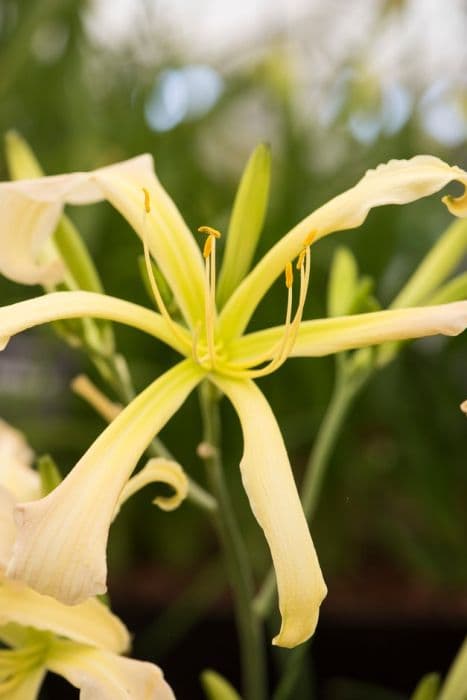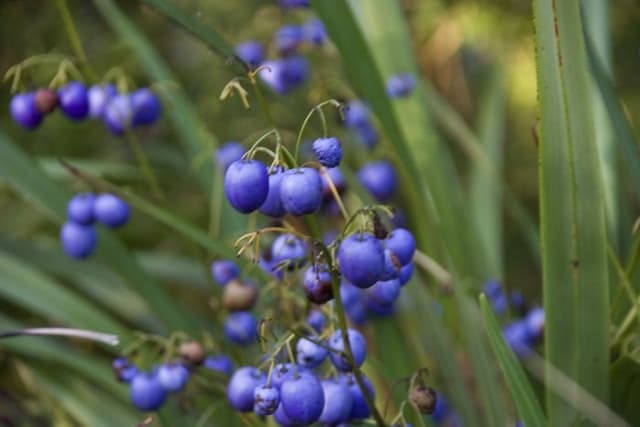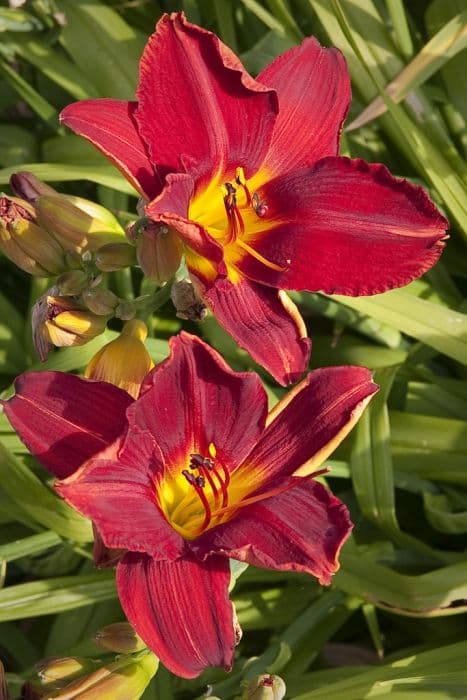Daylily Hemerocallis 'Womanizer'

ABOUT
The Hemerocallis 'Womanizer', commonly known as the Daylily 'Womanizer', features distinctive flowers characterized by their vibrancy and coloration. Each bloom presents a vivid display, with petals that may vary in shades from rich, deep reds to fiery oranges, although the specific coloration can depend on the variety. These dramatic flowers often have a velvety texture and may showcase a gradient of hues that draw the eye toward the throat, which could be of a contrasting color such as golden yellow or bright green, adding depth and intrigue to the flower's appearance. The daylily flowers possess a graceful trumpet-shape, unfurling from buds into large, flared blossoms that extend outward, creating an attractive star-like form when viewed from the front. The petals and sepals, the outer parts of the flower, are typically lengthy and may display ruffled or smooth edges, sometimes accented with delicate frills or pie-crusted margins that contribute to the flower's ornamental charm. The foliage of the Daylily 'Womanizer' is also noteworthy, forming a lush clump of long, slender leaves. These leaves are strap-like in shape, arching gracefully and emanating from the base of the plant. The greenery is a rich, verdant shade, making an excellent backdrop for the stunning blooms and adding to the plant's overall lushness. The leaves' length and arching nature create a fountain-like effect, which can provide a sense of movement and dynamism to garden settings. As a daylily, each individual flower typically lasts just a day, but the plant produces numerous buds that open in succession over a blooming period, providing a consistent display of color. Despite their fleeting existence, the flowers are prolific and the plant can produce multiple flowering stems, each bearing an abundance of blooms that contribute to a prolonged and spectacular show of color throughout its blooming season. In summary, the Daylily 'Womanizer' is a perennial that exhibits striking flowers of captivating colors and alluring shapes, together with lush, arching foliage that creates an attractive and dynamic presence in the landscape.
About this plant
 Names
NamesFamily
Hemerocallidaceae
Synonyms
Daylily
Common names
Hemerocallis 'Womanizer'.
 Toxicity
ToxicityTo humans
The Hemerocallis 'Womanizer', commonly known as the daylily, generally is not considered toxic to humans. In fact, some parts of daylilies are edible and are consumed in various cuisines around the world. However, it's important to note that while daylilies are not harmful to humans, they should not be confused with true lilies (Lilium species), which can be toxic if ingested. As with any plant, individual allergies or sensitivities could possibly occur.
To pets
The Hemerocallis 'Womanizer', commonly known as the daylily, is considered toxic to cats. Ingesting even a small amount of any part of a daylily can cause kidney failure in cats. Symptoms of daylily poisoning in cats may include vomiting, inappetence, lethargy, kidney failure, or signs of depression. If you suspect that your cat has ingested any part of a daylily plant, immediate veterinary attention is critical. Daylilies are not considered toxic to dogs, but individual sensitivities could potentially cause mild gastrointestinal upset if ingested.
 Characteristics
CharacteristicsLife cycle
Perennials
Foliage type
Deciduous
Color of leaves
Green
Flower color
Varies
Height
2 feet (0.61 meters)
Spread
2 feet (0.61 meters)
Plant type
Herb
Hardiness zones
3-9
Native area
Asia
Benefits
 General Benefits
General Benefits- Ornamental Value: The Hemerocallis 'Womanizer', commonly known as Daylily, has showy flowers that can be a stunning addition to a garden, providing visual interest and aesthetic appeal.
- Low Maintenance: Daylilies are known for being low maintenance, requiring minimal care once established, which is ideal for gardeners of all levels.
- Drought Tolerance: They are able to withstand periods of dry conditions, making them suitable for gardens in drought-prone areas.
- Adaptability: Daylilies can adapt to a wide range of soil types and environmental conditions, making them versatile for different garden settings.
- Pest Resistance: They are generally resistant to many pests, reducing the need for chemical treatments in the garden.
- Long Bloom Period: Daylilies can bloom for several weeks, often producing multiple flowers over the season, which can extend the time your garden has color.
- Propagation Ease: They can be easily propagated by division, allowing gardeners to create more plants and expand their garden displays or share with others.
- Erosion Control: The root systems of daylilies can help stabilize soil and control erosion on slopes or in areas with loose soil.
- Variety of Colors: Daylilies come in a vast array of colors and patterns, providing options to coordinate with different garden themes and color schemes.
- Wildlife Attraction: The flowers can attract pollinators like bees and butterflies, contributing to the health of your garden ecosystem.
 Medical Properties
Medical PropertiesThis plant is not used for medical purposes.
 Air-purifying Qualities
Air-purifying QualitiesThis plant is not specifically known for air purifying qualities.
 Other Uses
Other Uses- The Daylily 'Womanizer' can be used as a natural dye source for fabrics, providing a range of colors from soft yellows to greens depending on the mordant used.
- Daylily flowers are edible and can be used as a colorful garnish for salads or desserts, adding a slight sweet taste and crunchy texture.
- The blooms can be infused in water to create a fragrant Daylily flower water, which can be used in cooking or beverages for its aroma.
- Daylily petals can be pressed and included in craft projects such as homemade paper, providing texture and color.
- Dried Daylily flowers can be used as a natural potpourri, either alone or mixed with other flowers and spices.
- The roots of Daylilies can be used as an ingredient in compost or as a natural fertilizer, enriching the soil with nutrients.
- Daylily plants can act as a natural erosion control on slopes due to their extensive root system that holds the soil in place.
- The sturdy leaves of Daylilies can be woven to create small, rustic baskets or decorative accents in floral arrangements.
- Flowering Daylily plants can serve as indicators for garden health, as they may not bloom well if soil conditions are not ideal.
- Workshops and educational programs can use Daylilies to teach about plant hybridization and breeding due to their ease of pollination and variety of offspring.
Interesting Facts
 Feng Shui
Feng ShuiThe daylily is not used in Feng Shui practice.
 Zodiac Sign Compitability
Zodiac Sign CompitabilityThe daylily is not used in astrology practice.
 Plant Symbolism
Plant Symbolism- Beauty: Daylilies, the most common name for Hemerocallis, are known for their attractive blooms, symbolizing the appreciation of beauty in all forms.
- Transience: Each blossom typically only lasts for a day, which underscores themes of impermanence and the fleeting nature of life.
- Renewal and Motherhood: The prolific nature of daylilies, with new flowers blooming daily, can represent rebirth, motherhood, and the cycle of life.
- Survival and Adaptability: Daylilies are hardy plants that can survive in a range of conditions, symbolizing resilience and the ability to adapt to life's challenges.
 Water
WaterDaylilies, including the Hemerocallis 'Womanizer', should be watered deeply about once a week, providing enough water to soak the area around the roots. During hot or dry periods, increase the frequency to every 3 to 4 days. Apply approximately 1 inch of water each time, which is roughly equivalent to 0.6 gallons per square foot. To encourage deep root growth, avoid light sprinklings. Instead, focus the water at the soil level to minimize wetting the foliage, as wet leaves can encourage fungal diseases.
 Light
LightDaylilies like Hemerocallis 'Womanizer' thrive best in full sunlight, which means they should receive at least 6 hours of direct sunlight daily. They can tolerate light shade, especially in hot climates, but too much shade can reduce flowering. The ideal spot for planting 'Womanizer' daylilies would be in an area that gets bright morning sunlight with some protection from the intense afternoon sun.
 Temperature
TemperatureDaylilies, such as the Hemerocallis 'Womanizer', are tolerant of a wide range of temperatures but grow optimally in conditions between 60°F and 70°F. While they can survive brief periods of cold, dipping as low as 20°F, prolonged exposure could be harmful, and they can also handle heat up to around 90°F. The ideal temperature range for daylilies aligns with typical outdoor conditions in temperate climates without the need for special temperature control.
 Pruning
PruningPruning daylilies, including the Hemerocallis 'Womanizer', involves removing spent flower stalks and dead foliage to encourage reblooming and maintain a tidy appearance. Prune as soon as the flowers fade and stalks begin to yellow. Additionally, cut back the foliage to the ground in late fall or early spring to remove old growth and prepare for new shoots. Pruning is generally done on an as-needed basis throughout the growing season and more thoroughly once the plant is dormant.
 Cleaning
CleaningAs needed
 Soil
SoilDaylily 'Womanizer' thrives in well-drained, slightly acidic to neutral soil with pH 6.0 to 7.0. The best soil mix for this plant is a combination of loam, sand, and organic matter such as compost to ensure good drainage and fertility.
 Repotting
RepottingDaylilies like 'Womanizer' typically do not require frequent repotting and can thrive in the same spot for several years. Assess the need to repot or divide every 3 to 5 years to maintain vigor.
 Humidity & Misting
Humidity & MistingDaylilies, including 'Womanizer', are quite tolerant of varying humidity levels and do not have specific humidity requirements. Average garden conditions are typically adequate.
 Suitable locations
Suitable locationsIndoor
Grow 'Womanizer' Daylily in bright light and well-draining soil.
Outdoor
Plant 'Womanizer' Daylily in full sun to partial shade in fertile soil.
Hardiness zone
3-9 USDA
 Life cycle
Life cycleCommonly known as the daylily 'Womanizer', this perennial plant begins its life cycle as a seed, which germinates in warm, moist soil. The seedling stage follows, characterized by the emergence of the first leaves and roots as the plant establishes itself. As it enters the vegetative stage, the daylily produces a clump of strap-like leaves and begins to develop a strong root system. The plant reaches maturity in the flowering stage, where it produces large, colorful blooms that typically last just one day. Each flower arises from a flower stalk known as a scape, which emerges from the base of the plant. After flowering, if pollination occurs, the plant may produce seed pods, completing the cycle and allowing for the possibility of new plants to grow from the seeds.
 Propogation
PropogationPropogation time
Spring to early summer
Hemerocallis 'Womanizer', commonly known as daylily, is often propagated through division, which is the most popular method for this perennial plant. The best time to divide daylilies is in early spring or immediately after they finish flowering, which can vary but often occurs in late summer to early fall. To propagate by division, one should carefully dig up the clump of daylily plants, ensuring a generous amount of the root system is included with each section. Using a sharp knife or spade, the clump is then divided into smaller sections, making sure that each division has at least two to three fans of leaves and a portion of the root system. These divisions can be immediately replanted in the garden at the same depth they were growing before, spaced about 18 to 24 inches apart to allow for future growth. Water the newly planted divisions thoroughly to help establish them in their new location.









